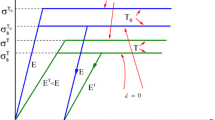Abstract
Conventional fire loads and fire resistances of a steel beam still lack an adequate correlation. This paper has established the relationship between the responses of restrained steel beams and fire actions by using a new definition of fire resistances and a new expression of fire loads. By using reduction factors of elastic modulus and yield strengths, has presented three critical equations to predict the limit state of a restrained steel beam in a fire. Based on these equations and the heat transfer formula, the paper provided a new definition of fire resistances. By using the heat release rate and effective rate coefficient of thermal absorption, a new expression of fire loads has been argued. Compared with tests, the proposed approach in this paper is in good agreement with the measured values in tests. The results show that the new fire resistances could be able to reflect the facts of heat transfers and duration time. In contrast to conventional fire loads, the new fire loads are more efficient to indicate a fire load.
Similar content being viewed by others
References
Ahn, J. K., Lee, C. H., and Park, H. N. (2013). “Prediction of fire resistance of steel beams with considering structural and thermal parameters,” Fire Safety Journal, Vol. 56, pp. 65–73, DOI: 10.1016/j.firesaf.2013.01.002.
American Institute of Steel Construction, Inc. (AISC). 2005. “AISC 360-05 Specification for Structural Steel Buildings.” Chicago(IL).
Bailey, C. G., Burgess, I. W., and Plank, R. J. (1996). “Analyses of the effects of cooling and fire spread on steel-framed buildings,” Fire Safety Journal, Vol. 26, No. 4, pp. 273–293, DOI: 10.1016/S0379-7112(96)00027-6.
Valencia, B., Lucas, T. R., Guillaume, E., Rein, G., and Torero, J. L. (2009). “Analysis of principal gas products during combustion of polyether polyurethane foam at different irradiance levels,” Fire Safety Journal, Vol. 44, No. 7, pp. 933–940, DOI: 10.1016/j.firesaf. 2009.05.003.
Cheng, X. D., Zhou, Y., Yang, H., and Li, K. Y. (2014). “Numerical study on temperature distribution of structural components exposed to travelling fire,” Procedia Engineering, Vol. 71, pp. 166–172, DOI: 10.1016/j.proeng.2014.04.024.
Dai, X. H., Wang, Y. C., and Bailey, C. G. (2009). “An experimental study of structural behaviour of joints in restrained steel frames in fires, applications of structural fire engineering.” In Proceedings of International Conference, Prague, pp. 350–355.
Dwaikat, M. M. S. and Kodur, V. K. R. (2011). “A performance based methodology for fire design of restrained steel beams,” Journal of Constructional Steel Research, Vol. 67, No. 3, pp. 510–524, DOI: 10.1016/j.jcsr.2010.09.004.
European Committee for Standardization (CEN). 2005. Eurocode 3:Design of Steel structures, Part 1-2:general Rules-Structural Fire Design, EN1993-1-2,Brussels.
Guo, Z. and Huang, S. S. (2016). “Behaviour of restrained steel beam with reduced beam section exposed to fire,” Journal of Constructional Steel Research, Vol. 122, pp. 434–444, DOI: 10.1016/j.jcsr.2016. 04.013.
Heidarpour, A. and Bradford, M. A. (2009). “Elastic behaviour of panel zone in steel moment resisting frames at elevated temperatures,” Journal of Constructional Steel Research, Vol. 65, No. 2, pp. 489–496, DOI: 10.1016/j.jcsr.2008.02.010.
Jiang, J., Chen, L. Z., Jiang, S. C., Li, G. Q., and Usmani, A. (2015). “Fire safety assessment of super tall buildings: A case study on Shanghai Tower.” Case Studies in Fire Safety 4 (July), pp. 28–38, DOI: 10.1016/j.csfs.2015.06.001.
Kodur, V. K. R., Naser, M., Pakala, P., and Varma, A. (2013). “Modelling the response of composite beam–slab assemblies exposed to fire.” Journal of Constructional Steel Research 80 (January), pp. 163–173, DOI: 10.1016/j.jcsr.2012.09.005.
Li, G. Q. and Guo, S. X. (2008). “Experiment on restrained steel beams subjected to heating and cooling,” Journal of Constructional Steel Research, Vol. 64, No. 3, pp. 268–274, DOI: 10.1016/j.jcsr.2007.07.007.
Li, G. Q., Wang, P. J., and Jiang, S. C. (2007). “Non-Linear finite element analysis of axially restrained steel beams at elevated temperatures in a fire,” Journal of Constructional Steel Research, Vol. 63, No. 9, pp. 1175–1183, DOI: 10.1016/j.jcsr.2006.11.009.
Liu, T. C. H., Fahad, M. K., and Davies, J. M. (2002). “Experimental investigation of behaviour of axially restrained steel beams in fire,” Journal of Constructional Steel Research, Vol. 58, No. 9, pp. 1211–1230, DOI: 10.1016/S0143-974X(01)00062-1.
Morandini, F., Perez-Ramirez, Y., Tihay, V., Santoni, P. A., and Barboni, T. (2013). “Radiant, convective and heat release characterization of vegetation fire,” International Journal of Thermal Sciences, Vol. 70, 83–91, DOI: 10.1016/j.ijthermalsci.2013.03.011.
NIST (2008}). “Final Report on the Collapse of World Trade Center Building 7, Federal Building and Fire Safety Investigation of the World Trade Center Disaster.” NIST NCSTAR 1A, USA
Quan, G., Huang, S. S., and Burgess, Ian W. (2015). “An analytical approach to modelling shear panels in steel beams at elevated temperatures,” Engineering Structures, Vol. 85, pp. 73–82, DOI: 10.1016/j.engstruct.2014.12.016.
Selamet, S. and Garlock, M. E. (2012). “Predicting the maximum compressive beam axial force during fire considering local buckling.” Journal of Constructional Steel Research 71 (April), pp. 189–201, DOI: 10.1016/j.jcsr.2011.09.014.
Spyrou, S. and Davison, J. B. (2001). “Displacement measurement in studies of steel T-Stub connections,” Journal of Constructional Steel Research, Vol. 57, No. 6, pp. 649–461, DOI: 10.1016/S0143-974X (01)00003-7.
Tan, K. and Huang, Z. (2005). “Structural responses of axially restrained steel beams with semirigid moment connection in fire,” Journal of Structural Engineering, American Society of Civil Engineers, Vol. 131, No. 4, pp. 541–451, DOI: 10.1061/(ASCE)0733-9445(2005) 131:4(541). “The Cardington and Broadgate Fires.” n.d. http://911research.wtc7.net/mirrors/guardian2/fire/cardington.htm.
Wald, F., Chlouba, J., and Kallerová, P. (2007). “Temperature of the header plate connection subject to a natural fire.” In Proceedings of Workshop “Urban Habitat Constructions under Catastrophic Events”, pp. 98–103.
Wald, F., Simões da Silva, L., Moore, D. B., Lennon, T., Chladná, M., Santiago, A., Beneš, M., and Borges, L. (2006). “Experimental behaviour of a steel structure under natural fire,” Fire Safety Journal, Vol. 41, No. 7, pp. 509–522, DOI: 10.1016/j.firesaf.2006.05.006.
Yang, D., Hu, L. H., Jiang, Y. Q., Huo, R., Zhu, S., and Zhao, X. Y. (2010). “Comparison of FDS Predictions by different combustion models with measured data for enclosure fires,” Fire Safety Journal, Vol. 45, No. 5, pp. 298–313, DOI: 10.1016/j.firesaf.2010.06.002.
Yii, E. H., Buchanan, A. H., and Fleischmann, C. M. (2006). “Simulating the effects of fuel type and geometry on post-flashover fire temperatures,” Fire Safety Journal, Vol. 41, No. 1, pp. 62–75, DOI: 10.1016/j.firesaf.2005.09.001.
Yin, Y. Z. and Wang, Y. C. (2004). “A numerical study of large deflection behaviour of restrained steel beams at elevated temperatures,” Journal of Constructional Steel Research, Vol. 60, No. 7, pp. 1029–1047, DOI: 10.1016/j.jcsr.2003.09.005.
Yin, Y. Z. and Wang, Y. C. (2005a). “Analysis of catenary action in steel beams using a simplified hand calculation method, Part 1: Theory and validation for uniform temperature distribution,” Journal of Constructional Steel Research, Vol. 61, No. 2, pp. 183–211, DOI: 10.1016/j.jcsr.2004.07.002.
Yin, Y. Z. and Wang, Y. C. (2005b). “Analysis of catenary action in steel beams using a simplified hand calculation method, Part 2: Validation for non-uniform temperature distribution,” Journal of Constructional Steel Research, Vol. 61, No. 2, pp. 213–234, DOI: 10.1016/j.jcsr.2004.07.003.
Author information
Authors and Affiliations
Corresponding author
Rights and permissions
About this article
Cite this article
Guo, Z., Gao, R., Zhang, X. et al. Fire Resistances of Restrained Steel Beams Subjected to Fire Loads. KSCE J Civ Eng 22, 3028–3038 (2018). https://doi.org/10.1007/s12205-017-0403-6
Received:
Revised:
Accepted:
Published:
Issue Date:
DOI: https://doi.org/10.1007/s12205-017-0403-6




